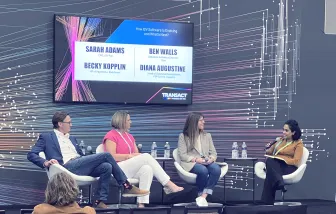An entire EV charging ecosystem, including payment technology companies and processors, to support this new, vital infrastructure.
Blog 1 in our series on EV charging stations highlights the fact that we’re at the beginning of a new era. We’ll see more and more electric vehicles on the road, and when they need more power, they’ll find a place to recharge, thanks to EV charging station partnerships.
Building a Public EV Charging Station Ecosystem
The U.S. Department of Transportation points out that partnerships are key to implementing public EV charging stations everywhere motorists need them. Planners and electric utilities must work with EV charging networks and site hosts to ensure that when a vehicle needs charging, the driver will be able to find a station.
But manufacturing charging stations themselves also requires expertise from various strategic partners to make them deliver the experiences that consumers demand. Businesses forming EV charging station partnerships include:
- Automakers
Automakers like Tesla are actively partnering with engineers to design and pilot public EV charging stations.
- OEMs
Original equipment manufacturers, such as Blink Charging, ChargePoint, ClipperCreek, and SemaConnect, provide vehicle charging equipment and cloud software.
- Supply chain partners
A range of materials and parts are necessary to build EV charging stations. Companies active in this market include electrical power products, automation systems, plastics and thermoplastics, batteries, enclosures, cables, electronic circuit boards, semiconductor chips, sensors, meters, and displays.
- Channel partners and service providers
To deploy public EV charging stations in a broad geographic area, including remote locations, OEMs are building channels of resellers and technicians trained to install charging stations.
What About Payments?
Among all the partnerships necessary to bring a functional public EV charging station to a parking lot or rest stop, payment technology may seem optional. The original vision for EV charging was to enable payment by app. The app would help the driver find a nearby charging station. Then, the connection fee plus the cost of electricity necessary is charged to the driver’s account. In some cases, the driver pays a subscription or membership to use the charging station; in others, the driver pays per charge.
However, this payment method alone won’t meet the needs of every driver. Some drivers may not have their smartphones with them when the vehicle needs charging. And others may have an app that isn’t compatible with the closest charging stations.
Additionally, there’s the issue of app fatigue. If consumers consider renting vehicles, for example, will they be willing to download another app and set up an account before they can reach their destination? Or will they limit their choices of where to rent based on the apps they have, in effect, impacting car rental companies’ revenues?
The solution that ensures drivers can use a public EV charging station when needed is integrated payments. Drivers should have a choice of using an app or paying directly at the station with an EMV card, contactless card, or mobile wallet to ensure that all public EV charging stations are accessible to everyone who needs them.
Payment partners that bring value to the public EV charging station ecosystem include payment technology companies that equip the station to read payment data and payment gateways that support unattended payments. And if the EV charging network partners with an omnichannel payments company, it can manage all types of payments from one platform.
The Power of Partnership
When drivers charge EVs, they probably won’t realize how many people with diverse skills made it possible. However, each is pivotal to creating the EV charging station infrastructure necessary to keep vehicles moving as more people choose EVs.
To learn more about unattended payments for EV charging stations, give us a call.











